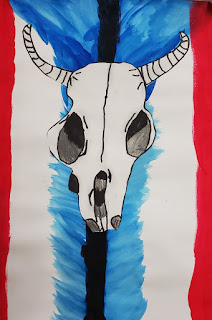Fourth Grade
2 Class Periods
50 minutes per class
About the Artist:
Georgia O'Keeffe was born in Sun Prairie, Wisconsin on November 15, 1887. At the age of 12, she knew she wanted to be an artist. This was a huge dream to have at this time, since most artist were men. Georgia enjoys painting abstract works of art that are inspired by the time she spent in New York and in New Mexico. Landscapes, flowers and skulls are the main subject matter she enjoys to paint. The artist past away on March 6, 1986. She was 98 years old. For this lesson we used Georgia's masterpiece Red, White and Blue for inspiration.
 |
| Red, White and Blue by artist Georgia O'Keeffe. |
 |
| Georgia O'Keeffe. |
Day 2:
We begin day two with a video clip featuring the artist being interviewed about her obsession with bones and what they mean to her. O'Keeffe Interview: Using Bones in Her Artwork.
After the video, students are given another 12 x 18 inch piece of white drawing paper. Through follow along instruction they are shown how to draw a skull on their paper and are given tips on how to shade the skull. Once the drawings are complete, they are cut out and glued to the background painted in the previous class.
Students were quite successful with this project. They enjoyed learning about an artist that grew up in a state in which they lived and were fascinated with the subject matter of bones. I am very fortunate to be married to a hunter, so I was able to bring in several deer skulls for the students to look at for inspiration for this project.
Student Examples:











































